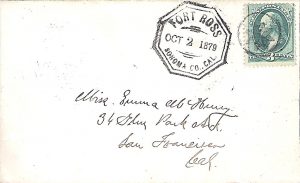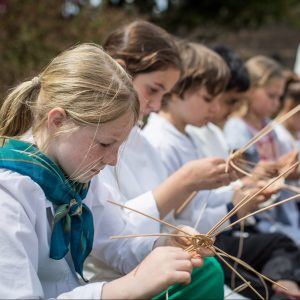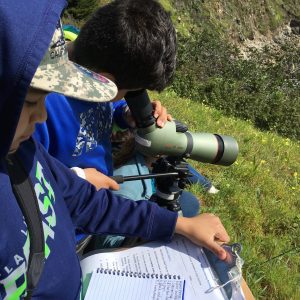OCTOBER 2020 ENEWS
Dear friends of Fort Ross and Salt Point,
November is upon us and I can begin to visualize the closing days of 2020. I know I’m getting a little ahead of myself with this but I am ready for a clean slate and the hope of a better year ahead. Twenty twenty has been extremely difficult on all of us - managing Covid-19, adapting to park closures, and dealing with multiple wildfires, one which scorched the southern border of our park and many more which affected our friends and communities.
It’s been a rough year and we need your help to launch a successful end-of-year fundraising drive to ensure Fort Ross remains a place of cultural connection and mutual understanding.
I am writing to ask for your donation to Fort Ross Conservancy. This year we need support for the overall health of our organization and for our Fort Ross Education Fund which supports bringing kids to our parks, or during the pandemic period, bringing our parks to the kids virtually.
Fort Ross Conservancy’s vision is to “connect people to the history and beauty of Fort Ross and Salt Point.” In a normal year, we bring over 4,000 youth to Fort Ross and Salt Point for meaningful overnight outdoor education. In a normal year we host tour buses and plan our big Fort Ross Festival bash and organize all sorts of wonderful gatherings. This work connects us to our communities, energizes our team, and provides our nonprofit with the funds to pay our dedicated staff. This year, as you probably know all too well, all that is out the window.
This year we’ve constantly adapted to the new normal with the goal of keeping our parks open. We’ve retrofitted the bookshop to ensure our guests and staff are safe. We’ve amplified our online presence by publishing dozens of original and interesting articles on social media covering all aspects of Metini / Fort Ross. (Click on the underline for a link to these articles.)
And most importantly, this season we’ve created fantastic virtual interactive programming to bring the Fort Ross history and landscape to the kids. These one-hour Distance Learning classes feature our instructors chatting live with students, intermixed with educational video snippets from the park as well as exercises and craft projects to engage the virtually adept generation. And while you can’t smell the salty Pacific waters or feel the fresh coastal air over Zoom, it is truly the best we have right now, and these kids need all the connections to nature we can provide. FRC wants to make these classes available to as many students as possible -- and that’s where you come in.
We want to keep the cost down and offer as many fee waivers as possible. If a class cannot pay, we can cover the cost from our Fort Ross Education Fund. Your donations help keep that fund solvent.
I sincerely miss seeing school kids at Fort Ross / Metini and I look forward to the day when we can open up all the buildings, hold all the events, and welcome everyone back - big groups, tour groups, yellow school buses, and more.
Please make a donation today. Donations of any size are greatly appreciated and for a small organization like ours, every donation makes a difference.
Also in today’s newsletter -
The United States Post Office is very much in the news these days, and this month’s e-news takes us back with a very timely and well researched article on the Fort Ross Post Office, complete with beautiful visuals.
Be well, be safe,
Sarah Sweedler
Fort Ross Conservancy CEO
Fort Ross Post Office (1877-1928) By John E. Allen
.jpg)
It has been nearly a hundred years since Fort Ross had a post office. Between the years of 1877 through 1928, the Fort Ross community was served by an eponymous post office. During the 51 years the Fort Ross Post Office was in operation during the “Ranch Era,” it served a small farming, dairy and lumbering community with fewer than a hundred residents. The Fort Ross post office was just one of 5,808 post offices in operation in California between 1849 and 1990. Fort Ross had two postmasters: George Washington Call, and his son, Carlos A. Call, the last owners of the Fort Ross ranch. Each operated the post office consecutively; 1877-1907 and 1907-28.
Geography had conspired to make the northern coast of California one of the most difficult areas to access on the planet. Transportation and communication, even under the best of conditions, was limited to mountainous paths and a few poorly maintained roads, or by equally dangerous travel by ship along the rugged coast. All of these factors left Sonoma and the adjoining counties extremely isolated from the outside world. This would be especially the case when it came to establishing tenuous mail routes. The delivery of mail was challenging to say the least when it came to road washouts, downed trees and the occasional road agent.
Postal communications began in California with the first European settlement and the arrival of the Spanish in 1769. Letters were used as official correspondence between the twenty-one missions, four presidios and three pueblos that made up the Spanish borderlands and the outside world. Soon after, as other Europeans and Americans began to show up along the coasts, residents had other options for dispatching mail. Still, Californios had few easy means of communicating with the outside world; either sending mail by a long and hazardous overland route to Mexico or by the sporadic arrival of ships along the coast. With the first appearance of the Russians in 1806, Alta California was opened up for the first time to trans-Pacific communication networks that included Siberia – and by extension European-Russia, Alaska, and the Hawaiian Islands.
The earliest letters took the form of sheets of writing paper folded and sealed with wax wafers. The outside would be addressed and sometimes dated by the sender and often docketed by those that received them with date received and a summary of the letter’s contents. With the introduction of paper envelopes in the 1840s, sheets of various sized paper were inserted into the gummed envelopes designed to be sealed by moisture. In time these envelopes became known as “covers.”
Official manuscript cancellations noting dates and places of the correspondence’s origins are known for the Spanish and Mexican periods. Eventually, officially-produced handstamp cancellations were applied to outgoing mail from Alta California. The earliest known example of such an inked, stamped cancelation is from 1834 carried by a military carrier between Monterey and San Diego. No known handstamp cancelations from the Russian-American colonies are known to the author, but they could easily exist in Russian archives and other collections. Some idea of this extensive volume of mail, sent and received, can be gathered from publications by James R. Gibson, W. Michael Mathes, and Glenn J. Farris.
The first large-scale use of metal or wooden handstamps was introduced to California with the California Gold Rush in 1848. From two official US post offices in that year, the number of post offices grew to over 500 by the 1860s. In 1847, the first postage stamps were introduced by the U.S. Post Office, and postage stamps became mandatory in 1856. These handstamps were mandated by postal regulation to include the name of the town, but also the state and the date (and sometimes the year) the letter was received by the post office.
The use of stamps also meant the need for some form of cancellation to prevent their reuse. These took many different forms: pen-and-ink manuscript crossing marks on the porous surface of the stamp, or inked metal or wooden hand stamp impressions. Because the use of manuscript cancellations predates the opening of the Fort Ross post office in 1877, none probably ever existed.
Since manuscript cancellations were prohibited after 1860, new devices came into use as stamp obliterators or “killers.” They were often produced by the postmasters themselves from anything at hand; cork, wood or metal. Before becoming standardized, these often took on very unique and creative designs. A new type of uniform machine cancelation came into use at the turn of the 20th century with 4-Bar stamp obliterators for the stamps as part of the whole circular cancelation.
Postmasters were not furnished with handstamps from the Post Office until 1884. Prior to that time, only post offices that produced $300 in annual revenue received them automatically. This meant that many postmasters had to purchase their own at a cost of between $1.50 and $2.50 from various suppliers. At no time during its early years of operation did the Fort Ross post receive the needed amount to be automatically issued a handstamp. Early on, handstamps took various forms, circular (usually 29-33 mm), oval, or a multisided shapes. An examination of early Fort Ross covers reveals the use of some interesting shapes, sizes and letter fonts.
Below are two 1879 Fort Ross covers using the earliest known handstamps. The first cover has a fancy octagonal handstamp typical of the 1870s and 1880s that also lists Sonoma County. It is accompanied by an 8-pointed star in circle “killer.” It is the earliest known date for this type.

.jpg)
Continue to read this article on our webpage at: https://www.fortross.org/history/post-office
FRC's Distance Learning - Inspiration through History & Ocean Stewardship
Fort Ross Conservancy now offers distance learning opportunities! We want to support California teachers and parents by bringing the park to you through a one hour distance learning program.
Environmental Living Program Distance Learning

Your ELP Distance Learning Experience Includes – Our ELP opportunities allow students to experience the joys of history, exploring the interaction between people and their environment. Students learn about the many cultures and ways of living at Settlement Ross. An ELP Instructor provides a virtual interactive walk-about of the historic compound to share this rich history, and provides tutorial videos of our many fun hands-on craft projects that students can do at home to bring this historic era to life. Experiences are a one hour interactive zoom activity with an FRC Educational Instructor. Programs are available: Tuesdays, Wednesdays, and Thursdays 10 a.m., 11:30 a.m., 1:00 p.m. Experience 1 – Fort Ross: Its History and People
- Learn how people lived and worked at Colony Ross through a virtual walkabout of the historic compound
- Settlement Ross, A Trading Outpost
Experience 2 – Environmental Living Program at Home & in the Classroom
- Incorporate our ELP curriculum into your classroom then join us for interactive demonstrations
Marine Ecology Program Distance Learning

Your Distance Learning Experience Includes – Learn how the history of Fort Ross is still, to this day, tied to the marine ecology along the Sonoma County coast. Fort Ross’ history provides a lens through which to examine the ways humans have cared for or exploited the environment around them. Its rich history — starting with the Kashia Pomo, followed by the Russians, Alaska Native and early California period — all instruct us to better understand how human impacts have lasting effects on ecosystems. A Fort Ross Conservancy MEP Instructor takes students on a journey through this California history which is carefully interwoven with local ocean ecology. Together we witness how the intersection of cultural and natural history offer a unique opportunity to learn ocean stewardship:
Experience 1 – One hour interactive Zoom experience
- Fort Ross, its History and Ecology
- Keystone Species Keep an Ecosystem in Balance
- Citizen Science – You Can Make a Difference!
- Exploring Tide Pools
Experience 2 – One hour interactive Zoom experience
- Citizen Science & Marine Mammal Monitoring at Fort Ross
- Harbor Seal and Sea Lion Surveys
- Exploring the Fur Warehouse
Cost – $5/person/hour – Fort Ross Conservancy is a nonprofit organization that works to connect people to the history and beauty of Fort Ross and Salt Point parks. We are dedicated to providing outdoor youth education for all students. The Fort Ross Distance Learning fees ensure FRC is able to continue providing excellent programming which utilizes Fort Ross’ unique cultural and natural history to teach important ocean stewardship lessons.
Fee Waivers Available! – Public lands and outdoor learning experiences should be widely available. FRC aims to minimize the financial challenges that keep kids from taking important field trips. Thanks to the generous support from our donors we have created the Fort Ross Education Fund to offer program fee waivers and/or transportation subsidies to schools that would otherwise be unable to participate. We welcome teachers of all schools to apply!
For more information contact Director of Programs Song Hunter at songh@fortross.org